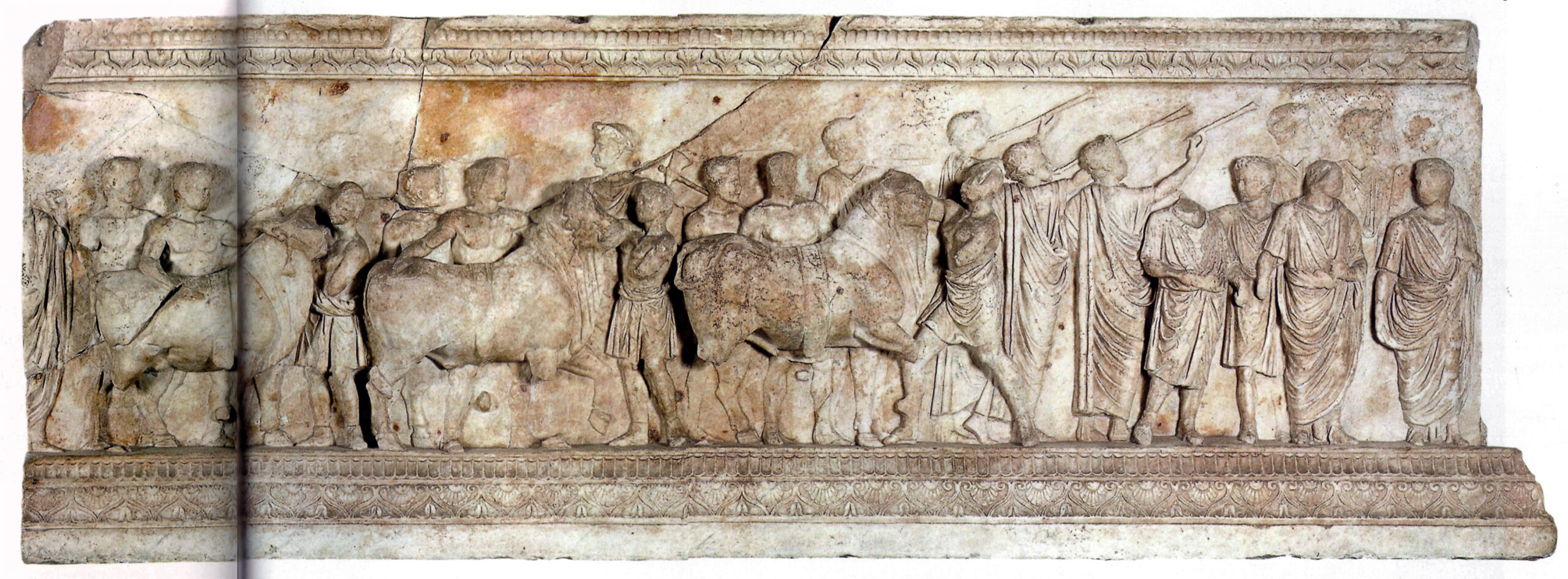Eumenes II’s pompe in Teos (Eumeneia)
| TITLE: |
| Eumenes II’s pompe in Teos (Eumeneia) |
| DATE: |
| Terminus ante quem 158 BC (190-160 BC) |
| ACTUAL LOCATION: |
| Fitzwilliam Museum at Cambridge (no. GR.39.1865) |
| TEXT: |
| CIG 3068 = PHI 256413 = AGRW 12823 (1) (2) |
| EDITIONS/TRANSLATIONS: |
CIG 3068 = PHI 256413 = AGRW 12823 STRANG, J. R. (2007): “The city of Dionysos: a social and historical study of the Ionian city of Teos” (Ph.D., State University of New York at Buffalo), pp. 279-280 |
| KEYWORDS: |
| Word used to mean procession: |
| πομπή (l. A.18-19, ἥ τε πομπὴ διέλθηι; l. B.22, ἐν ταῖς πομπαῖς) |
| Word used to mean the cult images: |
| εἰκόν (l. B27, εἰκόνα) ἀνδριάντα (l. A.23, παρὰ τὸν ἀνδριάντα τὸν Κράτωνος, from the word ἀνδριάς, “image of a man, statue”) |
| Gods or other entities named: |
| Dionysos Kathegemon (l. A.5, τὸν καθηγεμόνα Διόνυσον; l. B26-27) |
| Description of the cult images: |
| Procession’s route: |
| The procession ended in the theatre (l. A. 16, ἐν τῶι θεάτρωι; l. A.23, ἐν τῶι θεάτρωι; l. B.16-17, ἐν τῶι θεάτρωι) |
| Frequency with which the procession takes place: |
| Every year in the theater on the anniversary day of King Eumenes (l. A.16-18, ἐν τῶι θεάτρωι ὁ ἑκάστοτε γινόμενος ἀγωνοθέτης καὶ ἱερεὺς βασιλέως Εὐμένου ἐν τῆι βασιλέως Εὐμένου ἡμέραι) |
| Performers: |
| τὸ κοινὸν τῶν συναγωνιστῶν (CIG 3068, l. B.1); the synagonistai were assistants of the Dionysiac actors, but in this case, the designation probably extended towards musicians etc, as Kraton the aulos-player is called “one of them” (l. 13; cf. Aneziri 2003, p. 325) |
| References to the public attending the procession: |
| Rites related to the procession: |
“Common banquet” (l. A.15, κοινὸν δεῖπνον) Kraton is to be crowned during the association’s banquet and in the theatre (l. A.14-16) A pronouncement of the crown by the officials during the drinking festivities after the libations on the same day (l. A. 19-22, ὁμοίως δὲ καὶ παρὰ τὸν πότον γινέσθω τῆι αὐτῆι ἡμέραι μετὰ τὰς σπονδὰς ὑπὸ τῶν ἀρχόντων ἡ ἀναγγελία τοῦ στεφάνου. παρατίθεσθαι δὲ καὶ ἐν ταῖς θέαις) A tripod and an incense-burner were placed by the statue of Kraton in the theater, and the director of contests and the priest of King Eumenes in office each year undertook the fumigation (l. A.22-26, καὶ ἐν ταῖς πομπαῖς παρὰ τὸν ἀνδριάντα τὸν Κράτωνος τὸν ἐν τῶι θεάτρωι τρίποδά τε καὶ θυμιατήριον, καὶ τῆς ἐπιθυμιάσεως τὴν ἐπιμέλειαν καθ’ ἕκαστον ἔτος αἰεὶ ποιεῖσθαι τὸν ἀγωνοθέτην καὶ ἱερέα βασιλέως Εὐμένου γινόμενον) |
| Allusions to conduct or forms of reverence: |
| Other remarkable elements: |
It is a monument of marble that was erected in the Dionysion (l. 25), it was found in 1732 in the ancient city of Teos (Ionia), in Western Asia Minor, with a decree translated below involves honors for Kraton of Chalkedon by the Ionian-Hellespontine performers (centered at Teos) and the performers devoted to Dionysos Kathegemon (centered at Pergamon) |
| BIBLIOGRAPHY: |
ANERIZI, S. (2003), Die Vereine der dionysischen Techniten im Kontext der hellenistischen Gesellschaft. Untersuchungen zur Geschichte, Organisation und Wirkung der hellenistischen Technitenvereine. Stuttgart BÖMMER (1952), RE: s.v. Pompa. Herrscher, Vol. XXI.2, p. 1967, n.289-293 BOULAY, Th. (2013): “Les ‘groupes de référence’ au sein du corps civique de Téos”. In: P. Fröhlich, and P. Hamon (eds.), Groupes et associations dans les cités grecques (IIIe siècle av. J.-C. – IIe siècle apr. J.-C.), Genève, pp. 251-275 LE GUEN, B. (1997): De la scène aux gradins: théâtre et représentations dramatiques après, Presses Universitaires du Miral, Toulouse, p. 55 MA, J. (2007): “A Horse from Teos: Epigraphical Notes on the Ionian-Hellespontine Association of Dionysiac Artists”, in P. Wilson (ed.), Greek Theatre and Festivals, pp. 215-245 |
